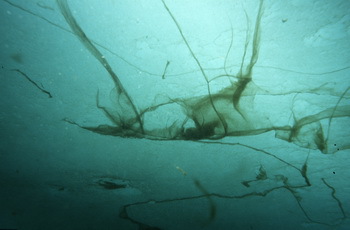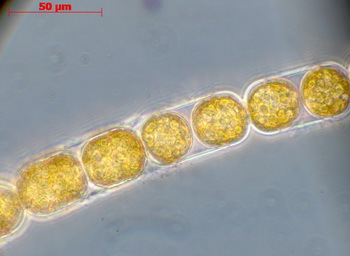Kategorie: News
Winner or loser of climate change?
 |
Researchers have named the Melosira arctica, one of the major algae species in the Arctic Ocean, as Algae of the Year.
“None of us can foresee whether the Melosira would be a victim or beneficiary of the melting sea ice. No one knows why it is the most productive algae in this hostile world,” said Dr Klaus Valentin, a biologist from the Alfred Wegener Institute for Polar and Marine Research, Helmholtz Centre for Polar and Marine Research (AWI).
A member of the Phycology Section of the German Botanical Society (Deutsche Botanische Gesellschaft), he was among the team of researchers who had bestowed the award to the Melosira arctica algae.
Valentin added that based on their latest genetic studies, the Melosira arctica was by far the most productive algae in the Arctic Ocean. In 2013, it accounted for 45 percent of primary production in the region.
With “cell” walls of only 30 micrometres in thickness consisting of silica, it has a protective gelatinous jacket made of polysaccharides. The single-celled alga links with one another to form algae filaments that hang from the underside of ice floes. These threads can be as long as several metres.
 |
Polar explorers have even found this algae in brine and meltwater pools, where they mostly grow in large quantities.
Even today, it is largely unknown how the Melosira arctica survives the long nights and harsh frost of the Arctic winter, and then multiply so extensively in the spring that it dominates the Arctic Ocean.
Even though diatoms (microscopic algae) form the foundation of the food chain and the Melosira arctica is a key organism in the Arctic ecosystem, the researchers do not know much about how it evolves or how it is influenced by environmental factors like light, nutrients or salinity. Hence, the species is now the focus of a new research project at the AWI.
Systematic analysis possible for the first time
Thus, the project – entitled “Melosira arctica in a changing Arctic Ocean” – was launched; it was one of AWI's first strategic projects. Different algae samples from the Arctic were collected, so as to extract pure cultures from them. These specimens were used to answer the biologists' many questions.
For instance, they were interested in how the algae responded to climate change. Since satellite measurements started in 1979, the sea-ice cover in the Arctic has shrunk significantly. Some climate models show the Arctic becoming ice-free during summertime by the second half of this century. Valentin wants to find out what would happen to the algae which his team found in and around the perennial ice.
 |
Physiological reaction of the “Ice Algae”
Most algae grow better when there is more light exposure and warmer seawater. Through photosynthesis, they get their energy and produce oxygen.
However, this may not be the case for the Melosira arctica. The oxygen produced can get stuck in air bubbles in the filaments of the Melosira arctica, adding to its bouyancy. Through their research, the scientists also want to know the temperatures at which the algae thrive and carry out photosynthesis, as well as how they deal with the range of nutrients that would vary with the temperatures.
In addition, they are also curious about the type of light conditions the algae can best tolerate
This is because light incidence, together with the dwindling ice, can inhibit microbial growth. It is within the controlled environment of a laboratory that all these variants can be measured easily and more accurately.
Melosira life cycle affects biomass in the deep sea
The recent years have seen excessive melting of the sea ice during the Arctic summer. During this time, the algae filaments detach, falling to the sea floor below where they are eaten by sea cucumbers and brittlestars. Due to climate change, this descent now takes place much sooner, so that as much as 85 percent of the biomass falls to the seafloor and is no longer available as food in the upper water column.
At the sea floor, bacterial decomposition occurs, consuming much of the oxygen and leading to large patches of oxygenless areas at the sea floor. This sequence of events has been observed on a Polarstern expedition in summer 2012.
Weitere Informationen: www.awi.de